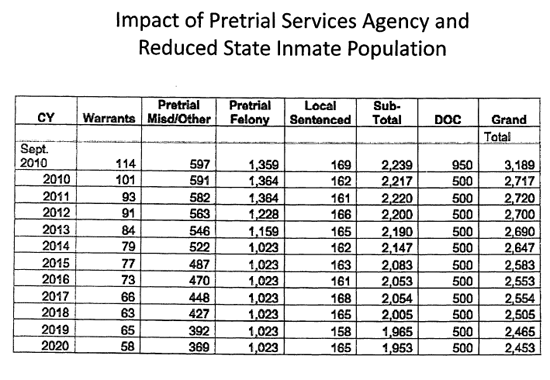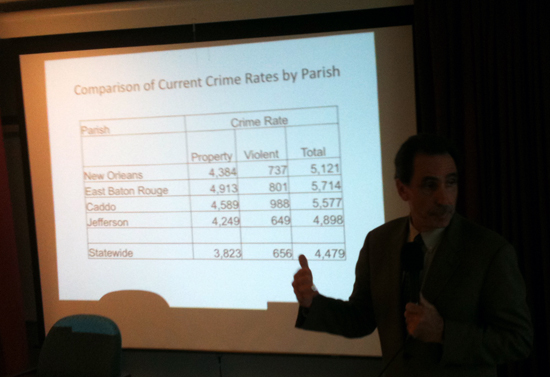By Matt Davis, The Lens staff writer
Mayor Mitch Landrieu may consider paying Orleans Parish Sheriff Marlin Gusman a flat fee to keep city inmates in his jail, rather than the current daily-rate arrangement which a consultant said only encourages more incarceration.
That same consultant, hired by Landrieu, has also recommended an Orleans Parish jail population of 2,450 by 2020 – sharply lower than the 8,000 projected recently for that year by Gusman.
Landrieu’s Criminal Justice Working Group met this afternoon at City Hall to hear a report by James Austin, a criminal-justice consultant working with the National Institute of Justice. The group is scheduled to make a recommendation to Landrieu on the size of a new jail and how to fund it by Nov. 22.
Austin suggested that the city move away from paying the sheriff per inmate, per day. He said Virginia is the only other place he knows with that arrangement.
“So basically the sheriff has an incentive to incarcerate people,” he said. “I think one of the things that would be very helpful would be to get off that budget structure.
“It doesn’t help if you want to get the jail population down as low as possible.”
Gusman applied to the city for permits for a 5,800-bed jail in April, while a coalition of smaller jail advocates has called for a jail of 850 beds, based on national incarceration averages.
Reducing the jail population to 2,450 would include introducing a pretrial services agency to cut down on city inmates awaiting trial, as well as halving the number of state inmates in the jail from 900 to 450 through a state-sponsored work release program.
“You’re completely off the planet in terms of the use of parish jail facilities to house state prisoners,” Austin said.
City Councilwoman Susan Guidry asked why.
“That’s a money thing…this produces jobs,” Austin said, referring to jobs for sheriff’s deputies.
Gusman introduced his own work-release program 10 months ago, and the Vera Institute of Justice of Louisiana has already secured funding to found the pretrial services agency.
“If the OPP prisoner population was strictly a function of violent or total crimes rates and the same criminal justice policies as exist in East Baton Rouge, Caddo, and Jefferson [parishes], the OPP population would be as low as 722 (Jefferson rates) and as high as 1,426 (Caddo rates),” Austin wrote in his report.
Orleans Parish actually now has a lower crime rate than East Baton Rouge and Caddo parishes, Austin said.
But New Orleans has historically incarcerated more people than those parishes, and looks set to continue to do so unless the city changes its policies dramatically.
To that end, Austin also suggested putting together a strategic reform plan to lower the number of jail facilities by 2015.
“Big picture stuff, this system is not growing,” Austin said. “It is going down right now. Can it get lower? It could. But it’s not going to get there by itself. You’ve got to change some policies for that to happen.”
A new jail is likely to take three years to build, once the council approves a conditional-use permit for the building.
Gusman is applying for a permit to build a 1,438-bed intake facility and housing unit, soon, as part of the first phase of his jail rebuild. Austin said there is “no question” that Gusman will be able to fill those beds by 2014. The question then would be which of Gusman’s outdated facilities to demolish first.
Not for the first time, Gusman bristled at the suggestion that the city’s daily rate gives him an incentive to keep more people in jail.
“You seemed to imply that there was an incentive to hold more people,” Gusman said. “If in fact it was the sheriff’s motivation to hold more people, would I have a fast-track release program?”
Austin responded in a placatory tone.
“I didn’t mean to imply, sheriff, that…you and I have good conversations,” Austin said. “The sheriff would love to have the smallest jail possible, but it’s got to be funded right, and it’s got to be safe, and it’s got to be humane.”
During audience questions, law professor Stephen Singer from Loyola University said the daily rate could be driving the city’s criminal justice policy, rather than the city’s criminal-justice policy driving the jail population.
Also during questions, civil-rights attorney Mary Howell pressured the city to change a federal consent decree that defines the city’s daily rate.
“It’s archaic and it’s obsolete,” Howell said.
That prompted support from Vera Institute of Justice of Louisiana director Jon Wool, who said the consent decree could be scrapped as long as the city ended up paying more than $22 per inmate per day with a fixed budget.
The city’s Chief Administrative Officer and Deputy Mayor Andy Kopplin said he’s more than open to the suggestion.
“I would like nothing better than to have a fixed budget that the sheriff gets to live on, than a flexible budget,” Kopplin told The Lens after the meeting. “And I think you’ll find that the sheriff would like that too.”
Gusman left the meeting without taking questions from reporters.
Two public meetings will be held to listen to public testimony on the proposed new jail next week. The first will be Tuesday at 6:30 p.m. at King Charter School, 1617 Caffin Ave. in the Lower 9th Ward. The second will be at a location to be determined on Thursday at 6 p.m.



